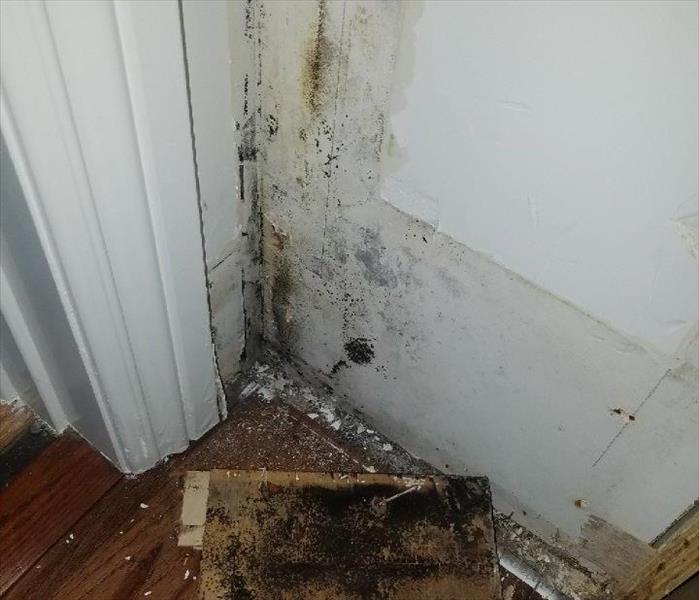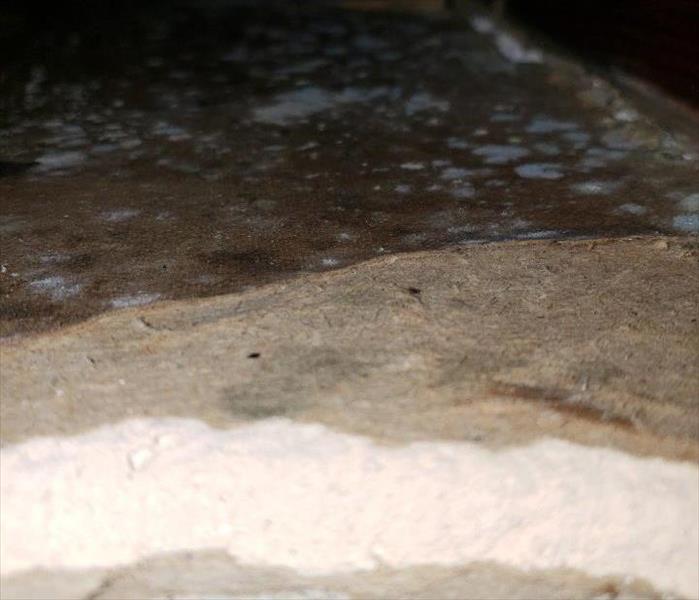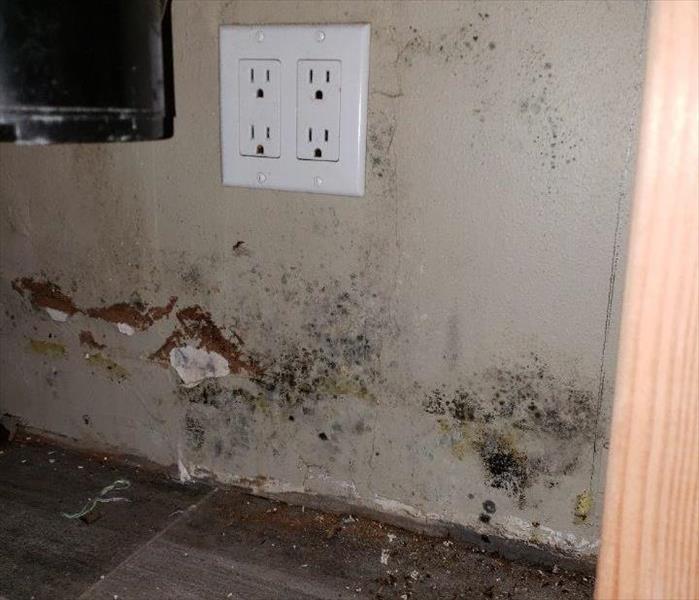Recent Mold Remediation Posts
Advice on how to deal with mold damages
10/9/2023 (Permalink)
Dealing with mold damage can be challenging, but it's essential to address it promptly to prevent further health risks and structural problems. Here are steps to help you effectively deal with mold damage:
1. **Assess the Extent of the Damage:**
- Thoroughly inspect the affected areas to determine the extent of the mold growth and damage. Identify the affected surfaces and materials.
2. **Prioritize Safety:**
- Wear appropriate protective gear such as gloves, goggles, and an N95 respirator to avoid exposure to mold spores. Ventilate the area to reduce indoor air contamination.
3. **Isolate and Contain the Mold:**
- Isolate the affected area to prevent the spread of mold spores to other parts of your home. Use plastic sheets and tape to seal off the affected space.
4. **Remove and Discard Contaminated Materials:**
- Remove and dispose of heavily contaminated materials such as drywall, insulation, carpeting, and other porous items that cannot be adequately cleaned. Bag and seal them before removal.
5. **Clean and Disinfect:**
- Clean non-porous surfaces with a mixture of water and detergent or a specialized mold cleaner. Disinfect the area using a solution of water and vinegar, hydrogen peroxide, or a commercial disinfectant.
6. **Dry the Area:**
- Ensure the affected area is thoroughly dried using fans, dehumidifiers, or other drying equipment. Mold thrives in damp environments, so reducing moisture is crucial in preventing its return.
7. **Address Moisture Sources:**
- Identify and address the source of moisture that allowed the mold to grow, such as leaks, water damage, or high humidity. Fix plumbing issues, repair roof leaks, and improve ventilation to prevent future mold growth.
8. **Consider Professional Help:**
- For extensive mold damage or if you're uncertain about how to proceed, consult a professional mold remediation service. They have the expertise and equipment to handle severe mold issues safely and effectively.
9. **Monitor and Maintain:**
- Regularly monitor the previously affected area and surrounding spaces for signs of recurring mold. Maintain proper ventilation, keep humidity levels in check, and promptly address any water damage to prevent future issues.
10. **Prevent Future Mold Growth:**
- Keep indoor humidity levels below 60% and use dehumidifiers in damp areas. Properly ventilate bathrooms, kitchens, and other areas prone to moisture. Regularly clean and maintain your home to prevent mold growth.
Remember, mold removal and remediation should be done safely and thoroughly to protect your health and prevent further damage. If you're unsure or uncomfortable handling the situation yourself, seeking professional help is always a good option.
FOUR COMMON STEPS FOR MOLD ASSESSMENT AND REMOVAL
1/9/2019 (Permalink)
If significant mold is detected in your home, it is important to deal with it immediately. Assessing mold growth involves more than just a visual inspection, however. Mold acts as a hidden intruder, growing in spaces out of sight. Should you discover mold in your house, you can expect these four common steps for professional mold remediation.
Documentation
The first step is to document the situation with writing and photos. The documentation will be used to develop a remediation plan, which describes when work is slated to begin, when that work is scheduled to be completed, who will be performing the remediation, any testing that should be done, and if homeowners will be temporarily relocated.
Inspection
Next, it is important to calculate the extent of the mold contamination. Since mold may not always grow in one area, determining the precise amount and its specific location(s) will lead to effective mold removal. Once an exact assessment is made, mold remediation may proceed.
Remediation
Remediation will always involve cleaning up existing mold, avoiding exposure to oneself and homeowners, and preventing new growth by addressing the moisture source. After repairing the water or moisture problem, cleaning can begin. All contaminated, non-porous materials and wood surfaces that are moldy can be cleaned at the professional's discretion.
Follow-Up
Just because the mold is gone and there's no dirt or dust doesn't mean that the job is done. The last step is to inspect the home soon after remediation and make sure there is no sign of visible mold, mold-damaged materials, or moldy odors. Homeowners should be able to occupy the home without aggravated health complaints.
If you suspect mold in your home, call SERVPRO of Northeast Long Beach / Lakewood for cleanup, restoration, and repair at 562-420-0030. We are available to take your call 24/7!
THE MOLD CLEANUP PROCESS
1/9/2019 (Permalink)
Mold often thrives undetected due to water or moisture damage. It is important to identify the extent of mold growth before it reaches a hazardous level by reaching out to a remediation team. If you require mold cleanup in your home, you can expect a professional to perform an assessment and devise a plan for your situation. Typically, they will perform the following steps for safe and effective removal.
Before cleanup can begin, it is important to fix the cause of the mold to prevent additional spores from growing. This process may involve fixing a leak, drying down a room, or pumping out water. Next, a professional will isolate the contaminated area by closing all doors and windows between the contaminated area and other rooms of the home, based on their discretion.
Once cleaning begins, a remediation specialist will usually suppress dust by misting the contaminated areas. All wet and mold-damaged porous materials should be removed, since contamination has already permeated throughout. They should be discarded in durable plastic bags, tied, and disposed.
Generally, non-porous materials and wood surfaces that are moldy can be cleaned based on the extent of damage. A wire brush can be used on all moldy surfaces and then wiped with disposable wipes.
A mild contamination can be cleaned with a damp cloth or mop with detergent solution, while a more severe area may require special HEPA vacuums designed to trap extremely small, micron-sized particles. All areas should be visibly free of contamination and debris, and cleaned materials should be dried to allow leftover moisture to evaporate. Fans and dehumidifiers will help speed up the drying process, and materials that were moved should be replaced or repaired.
If you require mold cleanup, call SERVPRO of Northeast Long Beach / Lakewood at 562-420-0030. We are available to take your call 24/7 and develop the correct course of action.
THE LEVELS OF MOLD DAMAGE
1/9/2019 (Permalink)
Often, it is difficult to determine the extent of mold damage, and there can be negative consequences caused from prolonged growth. When a contaminated area of any size is detected, a professional should be called to determine the best course of action to ensure the safety of those occupying the home. Here we will discuss the 5 levels of mold damage and typical actions for cleanup and removal.
Level 1 (0-10 Square Feet)
When addressed quickly and properly, level 1 mold is unlikely to cause a serious problems. A professional is likely to wear protective gear, remove contaminated materials in a plastic bag, and leave the area dry and free of mold contamination.
Level 2 (10-30 Square Feet)
Level 2 mold involves the same steps as level 1 with a few extra precautions. Moldy materials should be covered with double plastic sheets and sealed with tape before any handling or removal of materials to contain dust and debris. When the mold removal is finished, the area should be cleaned with a damp cloth and high-efficiency particulate air (HEPA) vacuum, depending on the situation.
Level 3 (30-100 Square Feet)
Mold level 3 usually indicates an underlying problem in the plumbing or air conditioning system. In addition to steps for the previous two levels, a professional may seal ventilation ducts in the work area and areas directly adjacent with plastic sheeting. Those residing in adjacent areas should be vacated as an extra precaution based on the discretion of the remediation professional.
Level 4 (Greater than 100 Square Feet)
For level 4 mold damage, every worker involved should be equipped with full face respirators and disposable protective clothing. Workers should completely isolate their work area from the rest of the home with sheeting sealed with duct tape. Air monitoring should be conducted prior to moving back into your home to determine if it is fit to reoccupy.
Level 5 (Air Conditioners and HVAC Systems)
Remediation procedures for air conditioning units and HVAC systems usually involve shutting down the system prior to remediation. Growth-supporting materials that are contaminated should be removed and sealed in plastic bags. Antimicrobial agents may be employed for greater mold removal as well.
SERVPRO of Northeast Long Beach / Lakewood is ready to help you with any project, big or small. Call us 24/7 at 562-420-0030 if you detect mold in your home.
MOLD: CERTAIN TYPES CAN CAUSE PROBLEMS
1/2/2019 (Permalink)
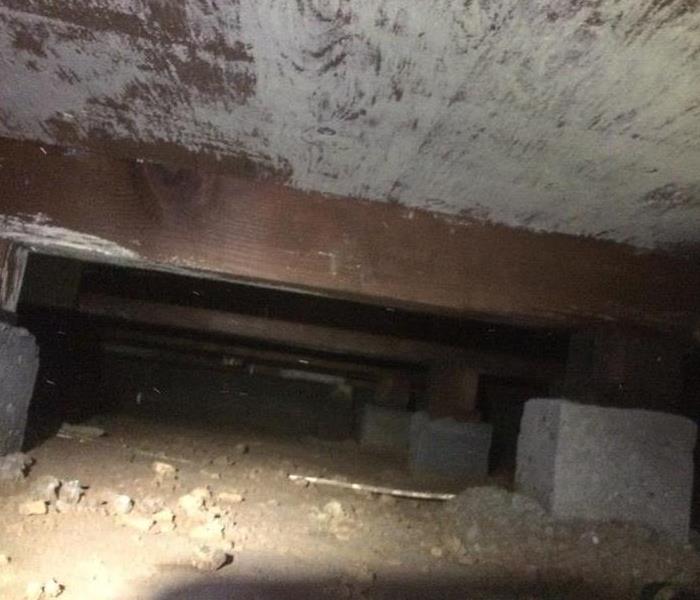 Mold in a Long Beach home's crawl space.
Mold in a Long Beach home's crawl space.
At SERVPRO of Northeast Long Beach/Lakewood, we deal with a lot of mold issues. We've learned that it’s estimated that more than 1 million types of mold exist, yet less than 10 percent have actually been named. This means mold is very common in both indoor and outdoor environments. While mold and humans can sometimes co-exist without issue, there are certain species of mold that can cause health effects for some people.
If the right conditions exist, mold will grow. Those conditions include:
- Water - Different mold types require varying amounts of liquid before growth begins.
- Temperature - Normal indoor temperatures will promote mold growth.
- Time - Initial mold colonizers can take hold within one day after being exposed to an adequate water supply.
Mold growth can occur in any home, so it’s important to keep an eye out for situations that might promote mold activity. Roof/chimney leaks, wet basements, or condensation from ducts that dampen surrounding insulation are just a few examples of issues that make a house a prime target for mold growth.
If you suspect mold in your home, call SERVPRO of Northeast Long Beach/Lakewood to assess the situation. We have the knowledge, tools and track record to effectively remediate mold in your home or business.
If you suspect mold, call us today at 562-591-1788.
What to Do:
- Stay out of affected areas.
- Turn off the HVAC system and fans.
Contact SERVPRO of Northeast Long Beach/Lakewood for mold remediation services.
MOLD: WHAT YOU CAN DO TO PREVENT ITS GROWTH
8/6/2018 (Permalink)
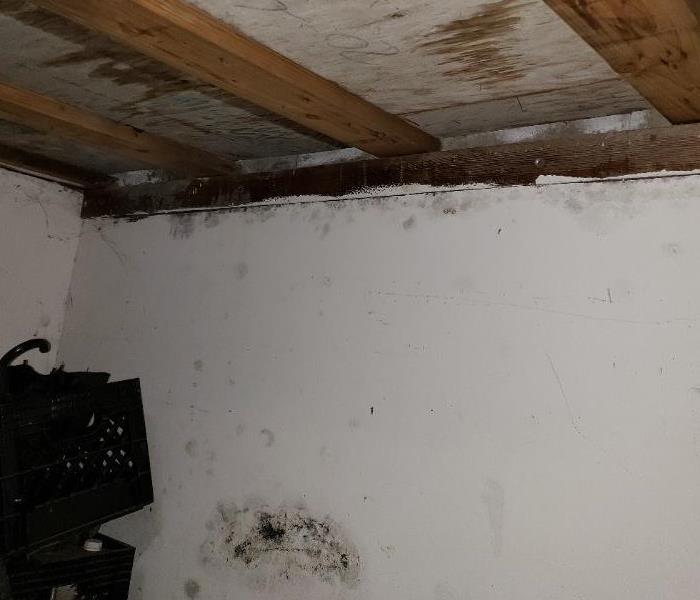 Mold in a storage unit in San Pedro
Mold in a storage unit in San Pedro
Mold is a type of fungi which grows in moist locations. Some mold is helpful and is used in medicines, some mold is delicious and is found in cheese or in the form of mushrooms. However, SERVPRO of NE Long Beach/Lakewood knows that other types of mold can be harmful to our health. It’s not healthy to inhale any type of mold spores, but some types of mold actually produce toxins, known as mycotoxins, that frequently cause a variety of health problems.
Once it’s been determined that your home or business has mold that must be remediated (testing is done and a protocol is written by an environmental consulting company), SERVPRO of NE Long Beach/Lakewood is there to contain the area, follow the protocol and remove the mold to ensure that you are living and working in a safe environment.
So how can we prevent the bad type of mold from growing in the first place?
Mold thrives in dark, moist areas. If your home or business has suffered a water loss remember that prompt mitigation is vital to avoid mold growth which can be visible in as little as 24 to 48 hours under certain conditions. Keep in mind that mold can grow on multiple places such as ceiling tiles, wallpaper, carpets, drywall and even wood.
Responding to water damages and other water intrusions immediately can prevent mold growth in those locations. When calling SERVPRO of NE Long Beach/Lakewood make sure to let them know how long this water damage could have been going on so we can inspect for mold growth as well.
Make sure to keep gutters and drains clear of debris. By keeping clear of build-up this prevents moisture from staying in the drains and will prevent mold from growing.
Regularly inspect plumbing and appliances for leaks.
Inspect the roof, windows and other areas where water might enter the building and perform necessary maintenance.
Having a mold issue can be dangerous to your health. Taking preventative steps to defend against mold growth is an important proactive step. When water loss occurs, prompt action and a call to SERVPRO of NE Long Beach/Lakewood (562) 420-0030 to insure that the affected areas in your home or business is thoroughly dried and the loss is properly mitigated is key.
MOLD IN LONG BEACH OR LAKEWOOD...DOES YOUR PROPERTY HAVE A PROBLEM?!
7/2/2018 (Permalink)
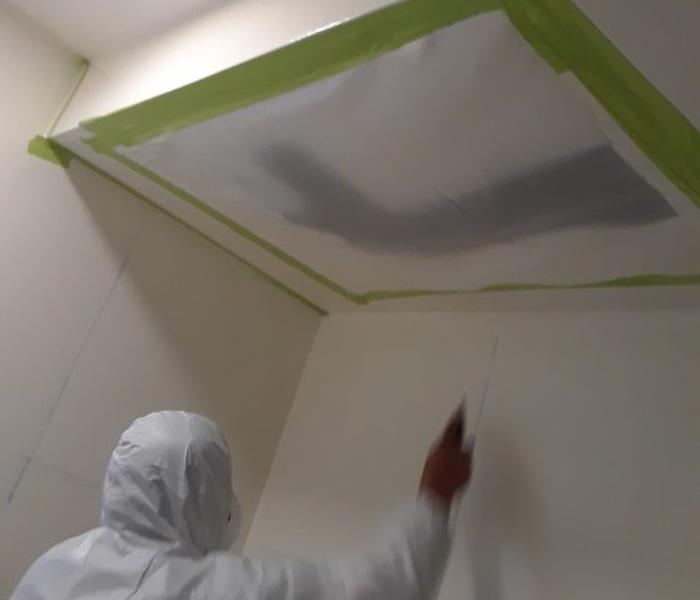 Mold Remediation in a Long Beach home
Mold Remediation in a Long Beach home
At SERVPRO of NE Long Beach/Lakewood we receive weekly calls from our residential or business property owners with questions or concerns about mold.
Microscopic mold spores naturally occur almost everywhere, both outdoors and indoors. This makes it impossible to remove all mold from a home or business. Therefore, mold remediation reduces the mold spore count back to its natural or baseline level. Some restoration businesses advertise “mold removal” and even guarantee to remove all mold, which is a fallacy. Consider the following mold facts:
- Mold is present almost everywhere, indoors and outdoors.
- Mold spores are microscopic and float along in the air and may enter your home through windows, doors, or AC/heating systems or even hitch a ride indoors on your clothing or a pet.
- Mold spores thrive on moisture. Mold spores can quickly grow into colonies when exposed to water. These colonies may produce allergens and irritants.
- Before mold remediation can begin, any sources of water or moisture must be addressed. Otherwise, the mold may return.
- Mold often produces a strong, musty odor and can lead you to possible mold problem areas.
- Even higher-than-normal indoor humidity can support mold growth. Keep indoor humidity below 45 percent.
If your home or business has a mold problem, we can inspect and assess your property and use our specialized training, equipment, and expertise to remediate your mold infestation.
If You See Signs of Mold, Call SERVPRO of NE Long Beach/Lakewood 562-420-0030
CERTAIN SPECIES OF MOLD SPELLS TROUBLE
2/16/2018 (Permalink)
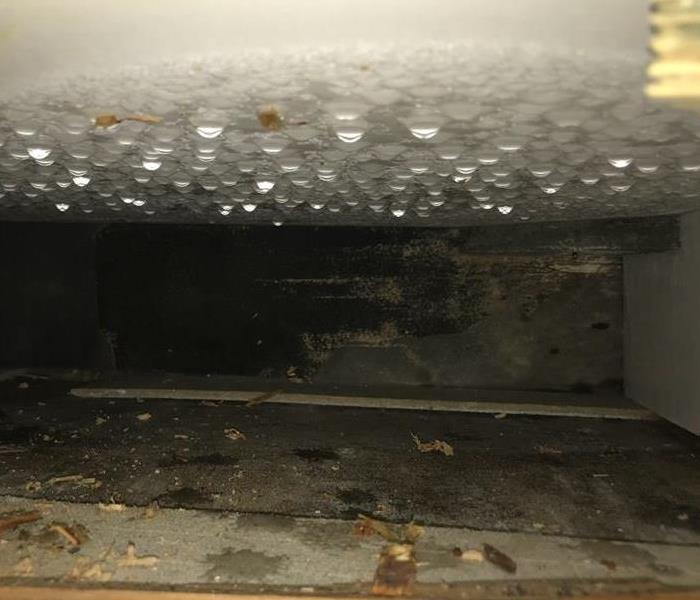 Mold growth and water condensation in Long Beach home
Mold growth and water condensation in Long Beach home
It’s estimated that more than 1 million types of mold exist, yet less than 10 percent have actually been named. This means mold is very common in both indoor and outdoor environments. While mold and humans can sometimes co-exist without issue, there are certain species of mold that can cause health effects for some people.
If the right conditions exist, mold will grow. Those conditions include:
- Water - Different mold types require varying amounts of liquid before growth begins.
- Temperature - Normal indoor temperatures will promote mold growth.
- Time - Initial mold colonizers can take hold within one day after being exposed to an adequate water supply.
Mold growth can occur in any home, so it’s important to keep an eye out for situations that might promote mold activity. Roof/chimney leaks, wet basements, or condensation from ducts that dampen surrounding insulation are just a few examples of issues that make a house a prime target for mold growth.
If you suspect mold in your home, call SERVPRO of NE Long Beach / Lakewood to assess the situation. We have the knowledge, tools and track record to effectively remediate mold in your home or business.
If you suspect mold, call us today at 562-420-0030
What to Do:
- Stay out of affected areas.
- Turn off the HVAC system and fans.
Contact SERVPRO of NE Long Beach / Lakewood for mold remediation services.





 24/7 Emergency Service
24/7 Emergency Service
